Genomic editing of genes involved in tumor suppression in animals
a gene and gene editing technology, applied in the field of gene editing of genes involved in tumor suppression in animals, can solve the problems of abnormal cell division, uncontrolled cell division, uncontrolled cell growth,
- Summary
- Abstract
- Description
- Claims
- Application Information
AI Technical Summary
Benefits of technology
Problems solved by technology
Method used
Image
Examples
example 1
Identification of ZFNs that Edit the p53 Locus
[0184]The p53 gene was chosen for zinc finger nuclease (ZFN) mediated genome editing. ZFNs were designed, assembled, and validated using strategies and procedures previously described (see Geurts et al. Science (2009) 325:433). ZFN design made use of an archive of pre-validated 1-finger and 2-finger modules. The rat p53 gene region (NM—030989) was scanned for putative zinc finger binding sites to which existing modules could be fused to generate a pair of 4-, 5-, or 6-finger proteins that would bind a 12-18 bp sequence on one strand and a 12-18 bp sequence on the other strand, with about 5-6 bp between the two binding sites.
[0185]Capped, polyadenylated mRNA encoding each pair of ZFNs was produced using known molecular biology techniques. The mRNA was transfected into rat cells. Control cells were transfected with mRNA encoding GFP. Active ZFN pairs were identified by detecting ZFN-induced double strand chromosomal breaks using the Cel-1 ...
example 2
Editing of the p53 Locus in Rat Embryos
[0186]Capped, polyadenylated mRNA encoding the active pair of ZFNs was microinjected into fertilized rat embryos using standard procedures (e.g., see Geurts et al. (2009) supra). Control embryos were microinjected with saline or mRNA encoding GFP. The injected embryos were transferred to pseudopregnant female rats to be carried to parturition. Toe / tail of clips of each live born animal was harvested for DNA extraction and analysis using a Cel-1 assay. As shown in FIG. 1, about 25% of the experimental animals had an edited p53 gene locus.
example 3
Inactivation of the p53 Locus in Rat
[0187]To determine that the edited p53 locus was inactivated, Western analyses were performed to confirm that no p53 protein was produced. Cell lysates were prepared from the kidney and liver of a wildtype animal and a p53 knockout animal. As shown on FIG. 2, both cytoplasmic and nuclear lysates of the p53 knockout animal were devoid of p53 protein. The levels of actin protein were constant among the wildtype and mutant samples, however. Thus, the p53 edited rat was a p53 knock-out rat.
PUM
| Property | Measurement | Unit |
|---|---|---|
| color | aaaaa | aaaaa |
| color figures | aaaaa | aaaaa |
| enzyme activity | aaaaa | aaaaa |
Abstract
Description
Claims
Application Information
 Login to View More
Login to View More - R&D
- Intellectual Property
- Life Sciences
- Materials
- Tech Scout
- Unparalleled Data Quality
- Higher Quality Content
- 60% Fewer Hallucinations
Browse by: Latest US Patents, China's latest patents, Technical Efficacy Thesaurus, Application Domain, Technology Topic, Popular Technical Reports.
© 2025 PatSnap. All rights reserved.Legal|Privacy policy|Modern Slavery Act Transparency Statement|Sitemap|About US| Contact US: help@patsnap.com



